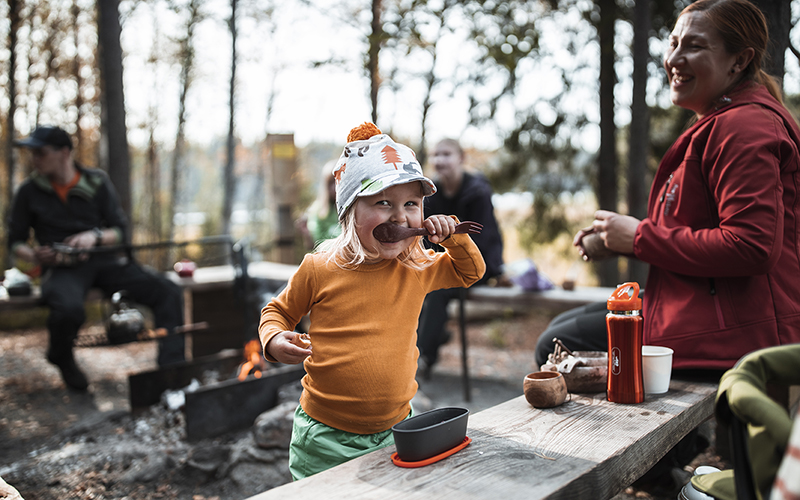The total number of visits to all state-owned protected areas and customer service points managed by Metsähallitus in 2020 was 9.2 million. Nearly 4 million of these visits were to National Parks. The number of visits to all nature sites increased by 17% over the previous year, and the number of visits to National Parks increased by 23%. Outdoor recreation and domestic tourism showed a strong increase during the COVID-19 pandemic. However, the pandemic alone did not account for the increase in nature recreation.
Metsähallitus has been monitoring visitor trends since 2001. The COVID-19 pandemic accelerated many of these trends but was not the cause of them. For example, the number of first-time hikers and diverse groups enjoying nature, such as mountain bikers and young people, has increased. The number of people hiking with children has increased, and there is an increasing number of overnight stays in nature. The popularity of typically remote or peaceful sites has also increased. A common denominator among all visitors is their desire to seek peace and enjoy the beauty of nature.

Improving and developing the hiking structures of nature sites with additional state funding, Metsähallitus, Parks & Wildlife Finland was able to manage the significant increase in the number of visits to National Parks and other nature sites in 2020.
– Investing in the enjoyment of nature produces results. We have increased funding to improve hiking structures at nature sites, which was something we really needed to do. Well-designed hiking structures attract people to nature and protect it’s natural values. Last year, the benefits of nature recreation were emphasised as Finns discovered nature with a new enthusiasm. I am pleased that satisfaction with our national parks and other nature sites also remained high. In 2020, it was 4.4 on a scale of 1–5 , says Minister of the Environment and Climate Change Krista Mikkonen.
The number of visits is anticipated to remain high even after the COVID-19 pandemic, as the growth is the result of long-term development. When the pandemic ends, foreign tourists will also return. Compared with the previous year, the number of visits to state-owned hiking areas also grew considerably, with an approximately total increase of 16%, or more than 300,000 visitors. In the Kvarken World Heritage Site the number of visits increased by 18% in the areas owned by Metsähallitus.
– In addition to the important one-off investment funding we received from the Ministry of the Environment and Ministry of Agriculture and Forestry for 2020 and 2021, Metsähallitus, Parks & Wildlife Finland got a rise of EUR 7.5 million for the level of its basic annual funding for its work in 2020, and this year the increase in the level funding is EUR 9.5 million. The continuation of increases in the level funding in the coming years is necessary, so that we will be able to continuously develop hiking services to meet demand, support nature-based tourism, promote the safeguarding of natural values even at the most popular sites, and ensure equality and customer safety, says Timo Tanninen, Director of Parks & Wildlife Finland.
Major changes in visitor spending – local economic impacts are not calculated
The pandemic influenced how visitors to protected areas spent their money. For example, vendors providing activity services were, as a rule, in a very difficult situation due to the lack of foreign visitors. The hotel and restaurant sectors also suffered. On the other hand, enterprises providing cottage accommodation services had a record year. In addition, food stores and fuel distribution points near nature sites, among other things, received a lot of new customers.
Local economic impacts based on protected-area-visitor spending data were not calculated for 2020 unlike in previous years. In order to calculate the impacts for local economies, data from visitor counters installed in the field is not enough, since also visitor spending data, obtained from visitor surveys, is necessary. The COVID-19 pandemic prevented this from being implemented with the exception of two sites, because the data from visitor surveys is collected by interviewing visitors in the field.
As the number of visits has increased considerably, local economic impacts have likely also increased at the national level, even quite strongly in some areas.
Partial closure of visitor centres – need for customer advice
The total number of visitors to visitor centres and other customer service points decreased by 23% (890,000 visits) due to the fact that the pandemic required their closure between 16 March and 31 May as well as for various short periods in the autumn. Demand fell primarily in visitor centres, whose closure occurred during a key part of the season.
However, there has been a high demand for hiking advice. and in areas where social sustainability has been put to the test. Indeed, Metsähallitus increased the amount of customer advice in the field, and the aim is to continue this development. There was also enormous growth in online services for outdoor enthusiasts: Compared with the previous year, the number of individual users of the Nationalparks.fi (including the language versions Finnish, Swedish and English) service increased by 49%, or 3.2 million individual users. Also, the number of visits to the Excursionmap.fi service increased 44%, totalling 3.8 million visits.
Visitor number statistics online
Further information:
Timo Tanninen, Director Parks & Wildlife Finland, + 358 (0)40 661 0033
Sakari Kokkonen, Recreational Amenity Manager, + 358 (0)400 241 411
Information on calculation methods: Liisa Kajala, + 358 (0)400 233 571